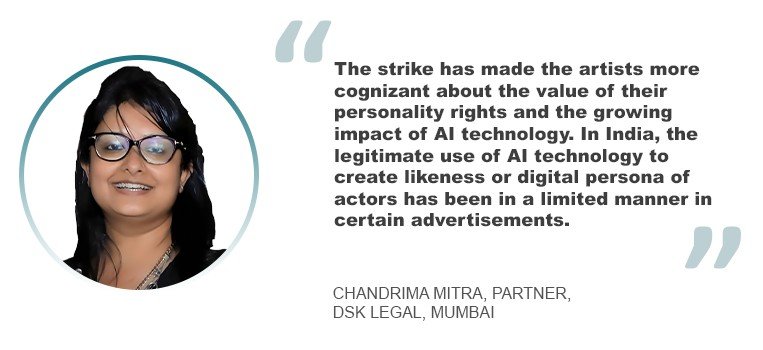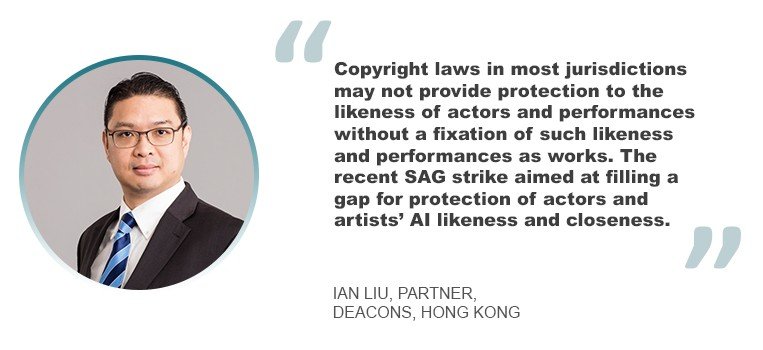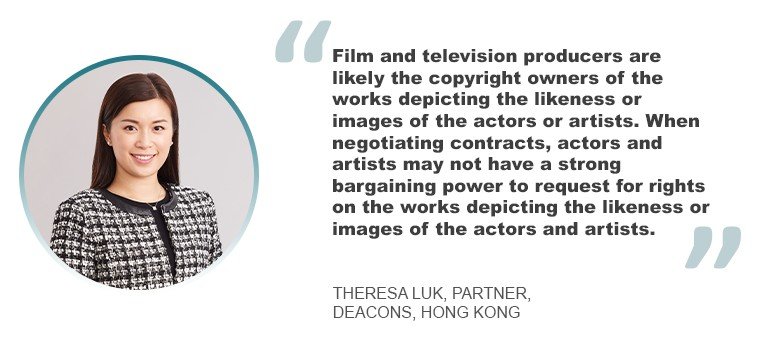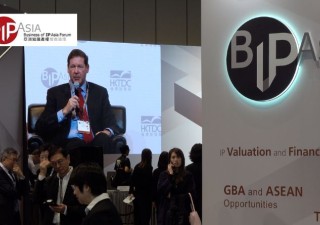In contrast, Singapore law does not recognize image rights or personality rights. Thus, there are no specific intellectual property or other rights that protect an actor’s or artist’s ability to commercially exploit their likenesses in the same way as in the United States.
“In Singapore, an actor or artist could protect his likeness through the torts of defamation or passing off,” said Sheng Rong Tng, a partner at Rajah & Tann in Singapore. “These torts protect a person’s reputation and goodwill respectively and may be engaged where an actor’s or artist’s likeness is utilized in a manner that negatively affects his reputation or goodwill. Whether this does, in fact, take place when an actor’s likeness is manipulated through AI would depend very much on how the likeness is utilized and what the end product is. This leaves a gap or lacuna in the law – there may be instances where an actor’s likeness is utilized in a manner that does not impact his reputation or goodwill, so there is no legal remedy in torts of defamation or passing off, yet the actor is not compensated for the use of his likeness.”
He added: “The good news is that present-day AI technology, while impressive, has not advanced to such a level that it is able to satisfactorily create digital likenesses and manipulate them to create or alter performances without a sufficiently large data set to train the generative AI system. Perhaps sometime in the future, AI technology will be able to create an entire likeness that can be fully manipulated, just based on a single video or image of an actor. But as of today, for AI to create the required digital likeness, thousands of images and videos must first be captured, through the actor spending hours in front of a camera and green screen to capture his face, movements, and voice. The actor still wields a sufficient level of control to dictate how his likeness is used. Thus, there is a window of opportunity for actors to engage with studios and production companies to ensure that their ability to commercially exploit their likenesses at reasonable levels of remuneration.”
He said that there are two main considerations when negotiating contracts involving the use and exploitation of an actor’s likeness in AI-generated content:
- The type of content that is produced. actors who do not wish for their likenesses to be associated with certain types of material (violence, nudity, gun- or drug-related content) should specify the types of content that their digital likenesses should or should not be used for. Actors could even negotiate for studios to seek their prior consent before utilizing their digital likenesses in any way.
- The level of compensation each time an actor’s digital likeness is used for AI-generated content. It is unlikely that this would be fixed by reference to the situation where the actor provides a real-life performance for the same content, since the actor has not in fact used the same time and effort to produce that content. However, it should nevertheless give due recognition to the commercial value of the actor’s likeness, bearing in mind the extent to which it forms a part of the overall material or content.
He said, “It would also be advisable for an actor to ensure that his consent for the studio to use his digital likeness is restricted to a particular project. One danger of providing express consent to one studio for one project is that it may constitute express consent or be deemed as implied consent for his digital likeness to be similarly used, either to other studios or for other projects. It would be difficult for an actor to adequately protect his ability to commercially exploit his likeness if he provides consent to the studio to use his digital likeness in any future project, or for any other use beyond projects.”
A balance between rights and innovation
According to Janet Toh, a partner at Shearn Delamore & Co. in Kuala Lumpur, the strike serves as a poignant reminder of the potential abuse and exploitation opportunities that artificial intelligence may pose to the creatives, and the need to balance between the protection of the actors and artists’ rights in their images and performances against the need for innovation and flexibility in the production and distribution of performances.
“It highlights the ground-breaking changes AI has brought to the entertainment world with its ability to simulate human expressions, emotions and movements, offering possibilities for creating realistic characters and enhancing performance through technologies such as motion capture and facial recognition without the consent of these actors and artists and their physical contribution,” she said. “This therefore impacts the economic and moral interests of these actors and artists and other stakeholders invested in the making of performances like producers.”
The strike has also raised the issue of how intellectual property should protect the digital replicas of actors and artists. Often, many of these actors and artists allege that their images have been coerced, replicated, used and in ways their original contracts never covered. Digital replica is a rather novel concept under the law. Informed consent for digital replica is one of the key issues in the negotiation.
“The actors fear a possible future in which studios will compel them to relinquish rights to their images, ultimately leading to their digital clones replacing them in the industry,” she said. “Particularly, the SAG strike focuses on the exploitation of background actors, who are known as extras, often appearing in the background of a scene, performing non-speaking parts. Generally, when the actors perform on film sets, the studios may have their images digitally scanned, and their voices digitally recorded. The strike stresses the concerns that these data may then be stored and utilized by the studios for any purposes without the actors’ consent. The studios may also be able to make changes to the actors’ dialogue, and even create new scenes without the actors’ informed consent. For the producers, digital replica is an efficient and cost-saving method to create crowd without requiring extensive physical shooting and manpower.”
She added: “However, for the actors, digital replica is a critical issue that will leave them vulnerable to having most, if not all, of their work being replaced by their digital clones. Intellectual property rights of the actors encompass legal protections and rights associated with their creative and intellectual contributions within the entertainment industry. Such rights vary from one jurisdiction to another and are generally governed by a combination of laws and legal principles, among others, the right to publicity and copyright law. Pursuant to the SAG strike, it is evident that there is a growing awareness amongst the members of the entertainment industry of their contractual bargaining power, particularly in terms of intellectual property rights. Contract negotiation holds significant importance for actors in terms of defining terms, among others, the usage of their image or likeness, and the fair compensation that entails. Through negotiations, actors can retain control over their intellectual property rights, including any potential sequels, spin-offs, or adaptations involving their performances.”












